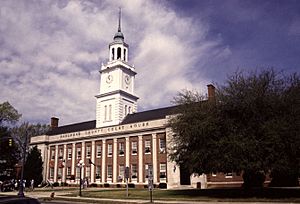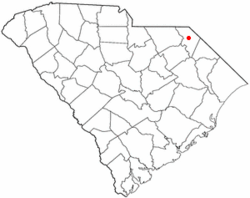Bennettsville, South Carolina facts for kids
Quick facts for kids
Bennettsville, South Carolina
|
|
|---|---|

The Marlboro County courthouse
|
|

Location of Bennettsville in South Carolina
|
|
| Country | United States |
| State | South Carolina |
| County | Marlboro |
| Area | |
| • Total | 6.80 sq mi (17.61 km2) |
| • Land | 6.17 sq mi (15.97 km2) |
| • Water | 0.63 sq mi (1.64 km2) |
| Elevation | 157 ft (48 m) |
| Population
(2010)
|
|
| • Total | 9,069 |
| • Estimate
(2019)
|
7,730 |
| • Density | 1,253.45/sq mi (483.92/km2) |
| Time zone | UTC−5 (EST) |
| • Summer (DST) | UTC−4 (EDT) |
| ZIP code |
29512
|
| Area codes | 843, 854 |
| FIPS code | 45-05680 |
| GNIS feature ID | 1246743 |
| Website | www.bennettsvillesc.com/ |
Bennettsville is a city located in the U.S. state of South Carolina on the Great Pee Dee River. As the county seat of Marlboro County, Bennettsville is noted for its historic homes and buildings from the 19th and early 20th centuries — including the Bennettsville Historic District which is listed on the National Register of Historic Places.
According to the 2010 census, Bennettsville has a population of 9,069.
Contents
Geography
Bennettsville is located at 34°37′17″N 79°41′5″W / 34.62139°N 79.68472°W (34.621270, -79.684830).
According to the United States Census Bureau, the city has a total area of 6.2 square miles (16 km2), of which, 5.6 square miles (15 km2) of it is land and 0.6 square miles (1.6 km2) of it (10.13%) is water.
History
The city of Bennettsville was founded in 1819 on the Great Pee Dee River and named after Thomas Bennett, Jr., then governor of South Carolina. The area was developed for short-staple cotton cultivation, dependent on the labor of enslaved African Americans. Many were brought to the upland area from the Lowcountry, carrying their Gullah culture with them. Others were transported from the Upper South by slave traders. This shift to cotton cultivation in the uplands was based on the development of the cotton gin, which made short-staple cotton, cotton with relatively short fibers, profitable. The advent of the gin in turn led to development of large cotton plantations throughout the Deep South.
In the same year, the S.C. General Assembly authorized the relocation of the courthouse from the eastern bank of the Great Pee Dee River to a more central location, selecting a 3-acre (12,000 m2) apple orchard located on a bluff above Crooked Creek. The new courthouse was designed by South Carolina architect Robert Mills. Streets were developed radiating courthouse square, one of the state's largest. In 1852, the Mills building was replaced.
In 1865 during the last year of the Civil War, the city was occupied by Union troops. During this time, the Jennings-Brown House and the first County Courthouse were used as the headquarters for General William T. Sherman. The new courthouse escaped burning. This is one of the few county seats that has preserved records dating to 1785; they are available for genealogical research.
In 1884, another Second Empire-style courthouse was built on the site. In 1952-1954 it was later enlarged with additions, and the 1884 portion constitutes the central portion of the current building. Additions included two-story red brick wings and the present clock steeple, all designed by Bennettsville architect Henry D. Harrall.
In 1885, Duncan Donald McColl financed development of the first railroad, bank and textile mills in Bennettsville, stimulating the economy as the town was connected to other markets and built an industry. The economy boomed during this "king cotton" era. The city became the center of one of the richest agricultural areas in the state. In the 20th century, the State of South Carolina designated Bennettsville as one its first "G.R.E.A.T. Town" (Governor's Rural Economic Achievement Trophy).
Historic architecture
Appin, the Bennettsville Historic District, Jennings-Brown House, Magnolia, Robertson-Easterling-McLaurin House, and the nearby Welsh Neck-Long Bluff-Society Hill Historic District are listed on the National Register of Historic Places.
The Bennettsville Historic District was designated and is listed on the National Register of Historic Places in 1978. Its contributing buildings include the Jennings-Brown House (1826), the Female Academy (1830), the Medical Museum (1902), and the Murchison School (1902), as well as other residences in the Queen Anne and Beaux Arts style.
What is known as the D. D. McColl house at 300 West Main Street is a South Carolina "mosquito cottage" built in 1826. Originally constructed by H. H. Covington on Darlington Street, it was sold in 1871 to Duncan Donald McColl (1842–1911). (This entrepreneur financed and developed the first railroad, bank, and textile mills in Marlboro County). McColl lived in the house until 1884, when he built a new residence on West Main Street.
Later the house was moved to S. Liberty Street, and later still to McColl Street, named after D. D. McColl. In the late 20th century, it was relocated to West Main Street, where it was restored and donated to the county in 1991 by Hugh L. McColl, Jr., Bennettsville native and D.D. McColl's great-grandson. The restoration included adaptation for use as offices by the Marlboro Chamber of Commerce and The South Carolina Cotton Trail, a heritage tourism group. It was relocated near D. D. McColl's Victorian brick residence, which was built in 1884.
Facilities
In the 21st century, a new Marlboro County library was constructed. Named in honor of national activist Marian Wright Edelman, who was born and grew up in Bennettsville, it opened on February 22, 2010. Edelman was born and grew up in Bennettsville, and became an activist. She founded the Children's Defense Fund, to promote programs for children and mothers.
The library is located on 4.4 acres (18,000 m2) at the intersection of Marlboro Street and Fayetteville Avenue adjacent to the Murchison building (1902) and the Northeastern Technical College, the new single-story building is approximately 20,000 square feet (1,900 m2). Its front tower is oriented on axis with that of the Murchison Building. The building's cost was supported by $1.325 million in federal funding. The Library holds 60,000 volumes and has two conference rooms, seating 50 and 12.
Demographics
| Historical population | |||
|---|---|---|---|
| Census | Pop. | %± | |
| 1880 | 343 | — | |
| 1890 | 978 | 185.1% | |
| 1900 | 1,929 | 97.2% | |
| 1910 | 2,646 | 37.2% | |
| 1920 | 3,197 | 20.8% | |
| 1930 | 3,667 | 14.7% | |
| 1940 | 4,895 | 33.5% | |
| 1950 | 5,140 | 5.0% | |
| 1960 | 6,963 | 35.5% | |
| 1970 | 7,468 | 7.3% | |
| 1980 | 8,774 | 17.5% | |
| 1990 | 9,345 | 6.5% | |
| 2000 | 9,425 | 0.9% | |
| 2010 | 9,069 | −3.8% | |
| 2019 (est.) | 7,730 | −14.8% | |
| U.S. Decennial Census | |||
2020 census
| Race | Num. | Perc. |
|---|---|---|
| White (non-Hispanic) | 2,089 | 29.76% |
| Black or African American (non-Hispanic) | 4,529 | 64.52% |
| Native American | 46 | 0.66% |
| Asian | 56 | 0.8% |
| Pacific Islander | 3 | 0.04% |
| Other/Mixed | 205 | 2.92% |
| Hispanic or Latino | 92 | 1.31% |
As of the 2020 United States census, there were 7,020 people, 2,850 households, and 1,684 families residing in the city.
Economy
The county is still largely rural, with limited job opportunities. The county seat serves as a trading center for the county.
The Federal Correctional Institution, Bennettsville was built outside of the city in the county. It is a medium-security prison for male prisoners, and has an associated minimum-security camp holding 139 prisoners. Together the facility houses 1776 prisoners.
Education
Bennettsville has a lending library, the Marian Wright Edelman Public Library.
Notable people
- Aziz Ansari, comedian and actor
- Marian Wright Edelman, founder of the Children's Defense Fund
- Hugh McColl, retired CEO of Bank of America
- Cozell McQueen, Starting Center on 1983 NC State NCAA Championship Team
- Jim Odom, MLB umpire
- Mike Wright, pitcher for Seattle Mariners
- Chancellor Williams, historian, writer and educator
See also
 In Spanish: Bennettsville (Carolina del Sur) para niños
In Spanish: Bennettsville (Carolina del Sur) para niños

